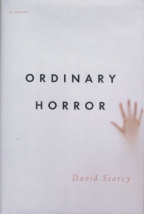Ordinary Horror
David Searcy
Viking / Penguin
US Hardcover First
ISBN 0-670-89476-1
Publication Date: 01-29-2001
230 Pages; $24.95
Date Reviewed: 10-10-02
Reviewed by Rick Kleffel © 2002

REFERENCES
COLUMNS
|
|
|
Ordinary HorrorDavid SearcyViking / PenguinUS Hardcover FirstISBN 0-670-89476-1Publication Date: 01-29-2001230 Pages; $24.95Date Reviewed: 10-10-02Reviewed by Rick Kleffel © 2002 |
|
|
REFERENCES |
COLUMNS |
"Here's a horror story for you," says David Searcy at the beginning of 'Ordinary Horror'. He then goes on to tell a story that is in fact very ordinary but not particularly horrific. Few readers would consider this first novel to be anything remotely resembling a horror novel, but it fits in perfectly with the long tradition of the Southern Gothic. Searcy's premise is very intriguing, but it doesn't play out the way a reader might expect it to. Horror novels are typically focused, slowly honing down on one moment, on one revelation. While 'Ordinary Horror' has that structure, the focus is deliberately soft. Searcy looks -- and looks and looks -- at the small inconsequential moments that everyone else is too busy to see. His novel becomes progressively more diffuse, making the reader feel more diffuse as well. It's an accomplished, powerful and off-putting performance. 'Ordinary Horror' is purely ominous.
The novel begins as Frank Delabano, a retired widower living in the suburbs discovers that his prized roses are being eaten from below by what appear to be gophers. He comes upon an advertisement for 'Gopherbane', a non-flowering plant from the Amazon that promises to rid his yard of gophers without harming kids or other plants. He orders the plant and then watches as the world around slowly grows vaguer, more ominous.
That about wraps up the plot of 'Ordinary Horror'. But it certainly doesn't encompass the novel. Searcy writes in the loping long sentences of other writers of Southern Gothic. He meanders about, taking his time, as if the writer himself were bored and not trying to hone in on the terrorizing emptiness that seems barely concealed by the dead world of Frank's suburb. Searcy soon shows himself to be a master of the suggestive comparison. He can capture those odd thoughts that stick with one and disturb, and he has the dreamy dreariness of the bland suburb nailed. If it were set in Tennessee, this novel would get comparisons to Faulkner.
Tiny events that wouldn't merit notice in other novels become reasons for major passages of prose and page-plus paragraphs. In other novels, these would seem like examples of the writer succumbing to what I call the "He walked to the car" syndrome, when the writer seems impelled to tell us every tiny detail and never edits experience to make the narrative move. Searcy offers up experience, unedited, unremarkable and turns it into a series of signs for some kind of Apocalypse. Frank faints at one point in the narrative, and things seem worse from that point on. Given that the character is elderly, there's good reason to think that he's suffered a minor stroke.
What other reason could make that dead, shapeless animal corpse seem so foreboding? Or the behavior of his neighbor's children so intimidating? It's certain that readers are unlikely to experience a barbecue grill in the same way they did before reading this novel. But a fairly significant percentage of readers will never actually finish 'Ordinary Horror'. It's pretty tough sledding and not in the least bit what you're going to expect from a strict recounting of the plot. Searcy's prose captures the meandering mind of an old man alone in a large house with such eerie perfection that many will simply find themselves bored, confused, or both. It's clear that Searcy knows precisely what he's doing and why. He's appropriated the techniques of Southern Gothic and applied the portentous biblical sense of enormity over the vast vapidity of life in the suburbs. He's absolutely nailed the empty terror of the mass-produced human, hiding in a tiny shelter from a world that threatens to unveil itself in a moment, to burst into a flame that burns away the mind that perceives it. Yes, 'Ordinary Horror' is pretty scary. And it deals with life at it's most mundane and ordinary. But it is certainly no ordinary horror novel.